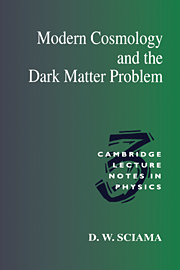Book contents
- Frontmatter
- Contents
- Preface
- Recent Developments
- Part One Dark Matter in Astronomy and Cosmology
- Part Two Ionisation Problems in Astronomy and Cosmology
- Part Three Neutrino Decay and Ionisation in the Universe
- 8 The Radiative Decay of Massive Neutrinos
- 9 Neutrino Decay and the Ionisation of the Milky Way
- 10 Neutrino Decay and the Ionisation of Spiral Galaxies
- 11 The Intergalactic Flux of Ionising Decay Photons
- 12 The Reionisation of the Universe
- Part Four Observational Searches for the Neutrino Decay Line
- References
- Subject index
12 - The Reionisation of the Universe
Published online by Cambridge University Press: 11 January 2010
- Frontmatter
- Contents
- Preface
- Recent Developments
- Part One Dark Matter in Astronomy and Cosmology
- Part Two Ionisation Problems in Astronomy and Cosmology
- Part Three Neutrino Decay and Ionisation in the Universe
- 8 The Radiative Decay of Massive Neutrinos
- 9 Neutrino Decay and the Ionisation of the Milky Way
- 10 Neutrino Decay and the Ionisation of Spiral Galaxies
- 11 The Intergalactic Flux of Ionising Decay Photons
- 12 The Reionisation of the Universe
- Part Four Observational Searches for the Neutrino Decay Line
- References
- Subject index
Summary
Introduction
In this chapter we study the implications of the neutrino decay theory for the reionisation of the universe and the consequent suppression of fluctuations in the microwave background. We saw on page 48 that we expect the early high temperature universe to have become neutral at a red shift ∼ 1000, when it had cooled down to a temperature ∼ 3000 K. On the other hand we know from considerations of the Gunn-Peterson effect that the intergalactic medium is highly ionised at redshifts between zero and 4.9. The questions then arise, at what red shift between 4.9 and 1000 did the reionisation occur, and by what process?
These questions, and the general thermal history of the universe, have been much discussed. They are obviously relevant to our understanding of the processes of galaxy formation. In addition it has long been realised that they play a crucial role in determining the present anisotropy ΔT/T of the microwave background on small angular scales. As has often been discussed (e.g. Efstathiou 1988 and references cited therein), if the postrecombination universe had been reionised so early that its optical depth for Thomson scattering exceeded unity, then the ΔT/T induced by fluctuations associated with galaxy formation after recombination at z ∼ 1000 would have been severely attenuated by z = 0. This is an important question because the present stringent observational limits on ΔT/T at small angular scales would impose severe constraints on several theories of galaxy formation in the absence of a scattering screen.
- Type
- Chapter
- Information
- Modern Cosmology and the Dark Matter Problem , pp. 169 - 176Publisher: Cambridge University PressPrint publication year: 1994



